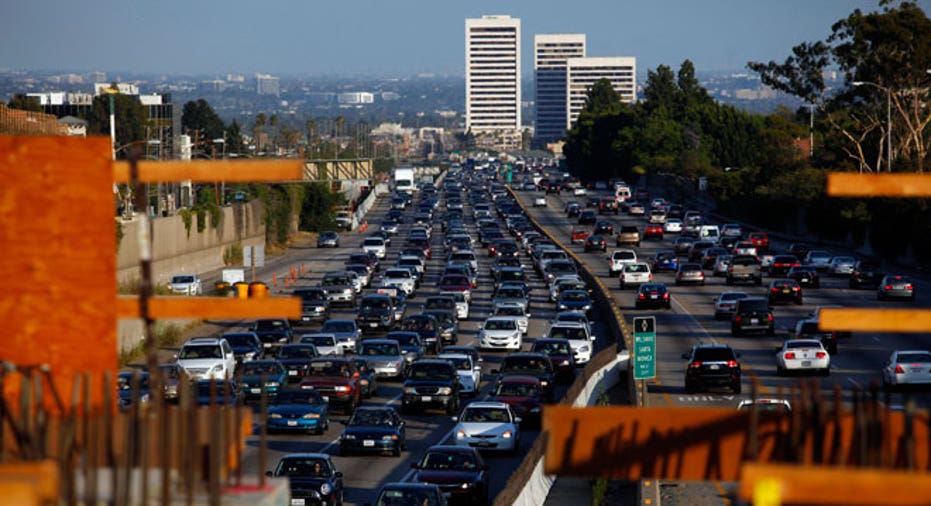Dangerous Driver Survey: Men Bothered by Phone Talkers, Women Irked by Lane Cutters

Men are more bothered than women by other drivers who talk on their phones but lane cutters irk the ladies more than guys, according to a survey by Progressive.
Progressive surveyed 1,700 people nationwide about their driving habits and also about their pet peeves when it comes to other motorists' unsafe (and often illegal) behavior behind the wheel.
The insurer, which says it conducted the survey to raise awareness about safe driving habits, found these driving behaviors by others bothered men and women as follows:
- Cellphone talking-- men 16%; women 9%
- Not using turn signals-- men 10%; women 13%
- Lane cutters-- men 8%; women 13%
- Weaving in and out of traffic -- men 8%; women 9%
When results are combined, texting topped the list, with about 28% saying they hated to see another driver doing it. Here are the other findings:
- Talking on the phone -- 13%
- Tailgating -- also 13%
- Not using turn signals -- 11%
- Lane-cutting -- 10%
- Weaving in and out of traffic -- 8%
Noisy passengers are more distracting than talking on a phone while driving, according to the survey. Nearly half (47%) cite loud passengers as more disruptive to concentration than their cellphones.
Get a grip: Three-Quarters Don't Know Correct Hand Placement on Wheel
Another notable survey result: Seventy-seven percent did not know that the correct hand placement on a steering wheel is 10 and three o'clock. Most drivers surveyed answered 10 and two o'clock, which, in their defense, was taught as the best placement for years before the small adjustment.
Eighty-two percent of motorists have had at least one "close call" with another vehicle in the past year. And, on average, drivers had six of these near-accidents. If you cause an accident, liability insurance pays for damages to the other car or property and for injuries to others, while collision insurance covers damage to your own vehicle.
But at least we're all buckling up, right? Perhaps not so much, 44% of respondents admitted they've broken the law by forgetting to wear a seatbelt at least once. Thirty-one percent said they've gone belt-less more than once during the year.
Texting, Tailgating Tickets and Car Insurance
Texting and talking on the cellphone behind the wheel are, of course, seen as much more than annoyances; the National Highway Traffic Safety Administration attributes as many as 3,000 highway deaths to them every year. Recognizing the dangers, states have aggressively moved to curb them.
Fourteen states -- including California, Connecticut, New York, Oregon and Washington -- and the District of Columbia prohibit all drivers from using handheld cellphones. And 38 states and D.C. ban all cellphone use, including hands-free use, for new drivers (usually 18 and under), according to the Governors Highway Safety Association.
As for texting, 44 states and D.C. have laws banning them for all drivers, and four -- Texas, Mississippi, Missouri and Oklahoma -- ban them for new drivers.
In some states, texting tickets add points to your driving record, which may trigger a rate hike if your insurer sees that upon review of your record, especially if you have other infractions or have been in a recent accident. (An analysis by Insurance.com shows your yearly rate could jump by about 13%, on average, if you're caught for tailgating, the survey's other top pet peeve.)
Here are examples of some states that tack on points if you're caught texting and driving:
- Alabama: 2 points are added
- New York: 5 points
- Vermont: 2 points for first offense and 5 points for a subsequent offense
- Virginia: 3 points
- Wisconsin: 4 points
Several states make an insurance surcharge less likely by specifying that breaking the texting law comes with a fine, but won't result in extra points or be considered a moving violation. Among them are:
- California: no points and not a moving violation
- Idaho: no points and not a moving violation
- Iowa: no points and not a moving violation
- North Carolina: no points and not a moving violation
- Washington: no points and not a moving violation
How to Trim Points From Your Driving Record
Here are two ways to mitigate a ticket (and help keep your rates from rising): Maintain a long period of violation-free driving and attend traffic school. If you've already got a few points, traffic school can also keep you from racking up a license suspension or veering into "driver responsibility fees," where states levy hundreds, even thousands of dollars in fees on bad drivers.
A few states, Virginia is one, offer "driver improvement clinics." Bad drivers take these courses either voluntarily or under orders from the DMV or a traffic judge. The Virginia DMV will trim as many as five demerits for completing an eight-hour class.
Here are a few examples of how other states approach points:
- In New York, drivers can take a Point and Insurance Reduction Program (PIRP) course to subtract 4 points from their record. Drivers who complete the course receive a 10% reduction, for three years, in the base rate of their current automobile liability, no-fault and collision premiums. Points associated with a violation are automatically removed after 18 months.
- In Pennsylvania, drivers must take an approved training course after hitting 6 points on their record. But on the positive side, 2 points are trimmed from their record after course completion. Beyond the class, 3 points are removed for every 12 consecutive months (from the date of the last violation) a motorist is violation-free.
- California automatically subtracts the demerit points for a violation after three years of safe driving.
The original article can be found at CarInsurance.com:Dangerous driver survey: Men bothered by phone talkers, women irked by lane cutters



















